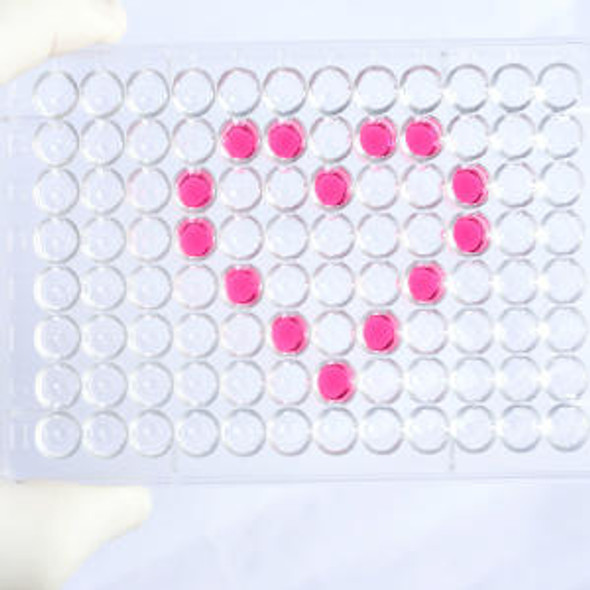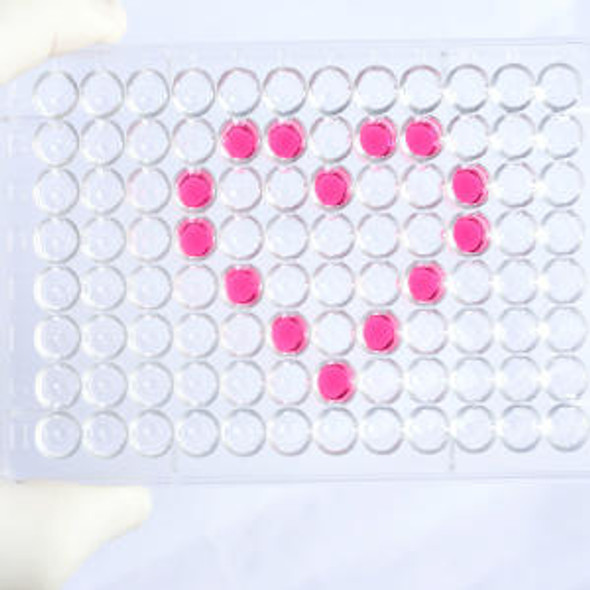Human Tryptase ELISA Kit
- SKU:
- HUFI02921
- Product Type:
- ELISA Kit
- Size:
- 96 Assays
- Sensitivity:
- 0.094ng/ml
- Range:
- 0.156-10ng/ml
- ELISA Type:
- Sandwich
- Synonyms:
- TPS
- Reactivity:
- Human
Description
Human Tryptase ELISA Kit
Tryptase is an enzyme primarily produced by mast cells, and its measurement is essential for diagnosing and monitoring mast cell activation-related disorders, such as anaphylaxis and mastocytosis. The ELISA (Enzyme-Linked Immunosorbent Assay) method allows for the accurate detection and quantification of tryptase by utilizing specific antibodies that bind to the enzyme. The kit provides a reliable and quantitative assessment of tryptase levels, aiding clinicians and researchers in understanding the underlying mechanisms of mast cell-related conditions and facilitating the development of appropriate treatment strategies.
Key Features
| Save Time | Pre-coated 96 well plate | |
| Quick Start | Kit includes all necessary reagents | |
| Publication Ready | Reproducible and reliable results |
Overview
|
Product Name: |
Human Tryptase ELISA Kit |
|
Product Code: |
HUFI02921 |
|
Size: |
96 Assays |
|
Alias: |
TPS |
|
Detection Method: |
Sandwich ELISA, Double Antibody |
|
Application: |
This immunoassay kit allows for the in vitro quantitative determination of Human TPS concentrations in serum plasma and other biological fluids. |
|
Sensitivity: |
0.094ng/ml |
|
Range: |
0.156-10ng/ml |
|
Storage: |
4°C for 6 months |
|
Note: |
For Research Use Only |
Additional Information
|
Recovery |
Matrices listed below were spiked with certain level of Human TPS and the recovery rates were calculated by comparing the measured value to the expected amount of Human TPS in samples.
|
||||||||||||||||||||
|
Linearity |
The linearity of the kit was assayed by testing samples spiked with appropriate concentration of [ANALYTE] and their serial dilutions. The results were demonstrated by the percentage of calculated concentration to the expected.
|
||||||||||||||||||||
|
CV(%) |
Intra-Assay: CV<8% |
Kit Components
| Component | Quantity | Storage |
|
ELISA Microplate (Dismountable) |
8x12 strips |
4°C for 6 months |
|
Lyophilized Standard |
2 |
4°C/ -20°C |
|
Sample/Standard Dlution Buffer |
20ml |
4°C |
|
Biotin-labeled Antibody (Concentrated) |
120ul |
4°C (Protection from light) |
|
Antibody Dilution Buffer |
10ml |
4°C |
|
HRP-Streptavidin Conjugate (SABC) |
120ul |
4°C (Protect from light) |
|
SABC Dilution Buffer |
10ml |
4°C |
|
TMB Substrate |
10ml |
4°C (Protection from light) |
|
Stop Solution |
10ml |
4°C |
|
Wash Buffer (25X) |
30ml |
4°C |
|
Plate Sealer |
5 |
- |
Other materials required:
- Microplate reader with 450 nm wavelength filter
- Multichannel Pipette, Pipette, microcentrifuge tubes and disposable pipette tips
- Incubator
- Deionized or distilled water
- Absorbent paper
- Buffer resevoir
Protocol
*Note: Protocols are specific to each batch/lot. For the exact instructions please follow the protocol included in your kit.
Before adding to wells, equilibrate the SABC working solution and TMB substrate for at least 30 min at 37°C. When diluting samples and reagents, they must be mixed completely and evenly. It is recommended to plot a standard curve for each test.
| Step | Procedure |
|
1. |
Set standard, test sample and control (zero) wells on the pre-coated plate respectively, and then, record their positions. It is recommended to measure each standard and sample in duplicate. Wash plate 2 times before adding standard, sample and control (zero) wells! |
|
2. |
Aliquot 0.1ml standard solutions into the standard wells. |
|
3. |
Add 0.1 ml of Sample / Standard dilution buffer into the control (zero) well. |
|
4. |
Add 0.1 ml of properly diluted sample ( Human serum, plasma, tissue homogenates and other biological fluids.) into test sample wells. |
|
5. |
Seal the plate with a cover and incubate at 37 °C for 90 min. |
|
6. |
Remove the cover and discard the plate content, clap the plate on the absorbent filter papers or other absorbent material. Do NOT let the wells completely dry at any time. Wash plate X2. |
|
7. |
Add 0.1 ml of Biotin- detection antibody working solution into the above wells (standard, test sample & zero wells). Add the solution at the bottom of each well without touching the side wall. |
|
8. |
Seal the plate with a cover and incubate at 37°C for 60 min. |
|
9. |
Remove the cover, and wash plate 3 times with Wash buffer. Let wash buffer rest in wells for 1 min between each wash. |
|
10. |
Add 0.1 ml of SABC working solution into each well, cover the plate and incubate at 37°C for 30 min. |
|
11. |
Remove the cover and wash plate 5 times with Wash buffer, and each time let the wash buffer stay in the wells for 1-2 min. |
|
12. |
Add 90 µl of TMB substrate into each well, cover the plate and incubate at 37°C in dark within 10-20 min. (Note: This incubation time is for reference use only, the optimal time should be determined by end user.) And the shades of blue can be seen in the first 3-4 wells (with most concentrated standard solutions), the other wells show no obvious color. |
|
13. |
Add 50 µl of Stop solution into each well and mix thoroughly. The color changes into yellow immediately. |
|
14. |
Read the O.D. absorbance at 450 nm in a microplate reader immediately after adding the stop solution. |
Sample Type
When carrying out an ELISA assay it is important to prepare your samples in order to achieve the best possible results. Below we have a list of procedures for the preparation of samples for different sample types.
| Sample Type | Protocol |
|
Serum |
If using serum separator tubes, allow samples to clot for 30 minutes at room temperature. Centrifuge for 10 minutes at 1,000x g. Collect the serum fraction and assay promptly or aliquot and store the samples at -80°C. Avoid multiple freeze-thaw cycles. If serum separator tubes are not being used, allow samples to clot overnight at 2-8°C. Centrifuge for 10 minutes at 1,000x g. Remove serum and assay promptly or aliquot and store the samples at -80°C. Avoid multiple freeze-thaw cycles. |
|
Plasma |
Collect plasma using EDTA or heparin as an anticoagulant. Centrifuge samples at 4°C for 15 mins at 1000 × g within 30 mins of collection. Collect the plasma fraction and assay promptly or aliquot and store the samples at -80°C. Avoid multiple freeze-thaw cycles. Note: Over haemolysed samples are not suitable for use with this kit. |
|
Urine & Cerebrospinal Fluid |
Collect the urine (mid-stream) in a sterile container, centrifuge for 20 mins at 2000-3000 rpm. Remove supernatant and assay immediately. If any precipitation is detected, repeat the centrifugation step. A similar protocol can be used for cerebrospinal fluid. |
|
Cell culture supernatant |
Collect the cell culture media by pipette, followed by centrifugation at 4°C for 20 mins at 1500 rpm. Collect the clear supernatant and assay immediately. |
|
Cell lysates |
Solubilize cells in lysis buffer and allow to sit on ice for 30 minutes. Centrifuge tubes at 14,000 x g for 5 minutes to remove insoluble material. Aliquot the supernatant into a new tube and discard the remaining whole cell extract. Quantify total protein concentration using a total protein assay. Assay immediately or aliquot and store at ≤ -20 °C. |
|
Tissue homogenates |
The preparation of tissue homogenates will vary depending upon tissue type. Rinse tissue with 1X PBS to remove excess blood & homogenize in 20ml of 1X PBS (including protease inhibitors) and store overnight at ≤ -20°C. Two freeze-thaw cycles are required to break the cell membranes. To further disrupt the cell membranes you can sonicate the samples. Centrifuge homogenates for 5 mins at 5000xg. Remove the supernatant and assay immediately or aliquot and store at -20°C or -80°C. |
|
Tissue lysates |
Rinse tissue with PBS, cut into 1-2 mm pieces, and homogenize with a tissue homogenizer in PBS. Add an equal volume of RIPA buffer containing protease inhibitors and lyse tissues at room temperature for 30 minutes with gentle agitation. Centrifuge to remove debris. Quantify total protein concentration using a total protein assay. Assay immediately or aliquot and store at ≤ -20 °C |
|
Breast Milk |
Collect milk samples and centrifuge at 10,000 x g for 60 min at 4°C. Aliquot the supernatant and assay. For long term use, store samples at -80°C. Minimize freeze/thaw cycles. |
Tryptase Background
Tryptase Background
Tryptase is a serine protease, largely synthesized and stored in mast cells (MCs) and is also present in smaller amounts in blood basophils. Regardless of the organ, location of the MCs, stage of maturation, or subtype of the MCs, tryptase is generated and secreted in tissue MCs in a constitutive way. Additionally, mature tissue MCs store more of the enzyme in their metachromatic granules. Alpha- and beta-tryptase are the two main types of tryptase that are formed in MCs. The beta form is predominantly kept in MC granules, but the alpha form is continuously created and released in MCs. Alpha- and beta-tryptases are immediately released in significant levels by MCs during an anaphylactic reaction. After degranulation, MCs also manufacture tryptase during the healing process, and they regranulate to "fully equip" tryptase+ effector cells.
Tryptase Inhibitors
Tryptase inhibitors are pharmacological agents designed to block or inhibit the activity of the enzyme tryptase. By inhibiting tryptase, these compounds aim to modulate the exaggerated release of inflammatory mediators, which can lead to various allergic reactions and inflammatory disorders, such as asthma and allergic rhinitis. Tryptase inhibitors hold potential therapeutic value in managing conditions associated with mast cell activation, as they can help mitigate symptoms and reduce the severity of allergic responses.
Tryptase Levels
Tryptase levels can vary depending on the individual, the specific assay used for measurement, and the laboratory's reference range. In general, normal total serum tryptase levels in healthy individuals typically fall below 11.4 ng/mL. It's important to note that tryptase levels can increase in certain conditions, such as anaphylaxis, mastocytosis, and other mast cell activation-related disorders. In these cases, tryptase levels can significantly exceed the normal range.
Tryptase ELISA Kit FAQs
What is the Tryptase ELISA Kit used for?
The kit provides a reliable and quantitative assessment of tryptase levels, aiding clinicians and researchers in understanding the underlying mechanisms of mast cell-related conditions and facilitating the development of appropriate treatment strategies.
What are the advantages of using the Tryptase ELISA Kit?
The Tyrptase ELISA Kit offers several advantages, including high sensitivity, accuracy, and reproducibility. It provides a user-friendly and reliable method to quantify Tryptase levels in biological specimens, allowing for precise measurements and robust data analysis.
What sample types are compatible with Tryptase ELISA Kit?
The Tyrptase ELISA Kit is compatible with various sample types, including serum, plasma, cell lysates, and tissue homogenates. It provides flexibility in sample selection, allowing researchers to analyze Tryptase levels in different biological matrices.
What are the storage requirements with Tyrptase ELISA Kit?
The Tyrptase ELISA Kit components should be stored according to the instructions provided in the kit manual. Generally, it is recommended to store the kit components at the recommended temperature to ensure their stability and optimal performance.
What should I do if my assay results are not optimal?
If you encounter any issues or have suboptimal assay results, we recommend contacting our dedicated support team for assistance. They will be available to provide troubleshooting guidance, answer your questions, and ensure you achieve the best possible results with the Tryptase ELISA Kit.





